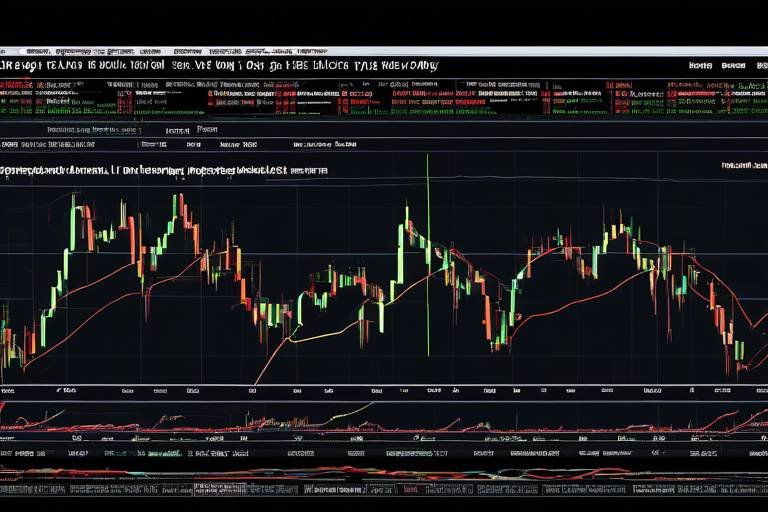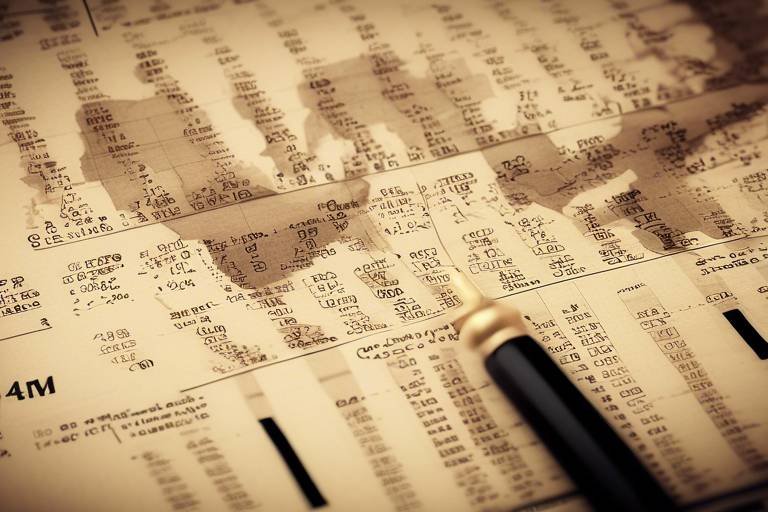Analyzing Your Trading Results - What to Look For
When it comes to trading, the journey is as important as the destination. Analyzing your trading results is not just a mundane task; it's an opportunity to unlock the secrets of your performance. By diving deep into your trading history, you can uncover valuable insights that can propel you towards greater success. But what exactly should you be looking for? Let's break it down.
First and foremost, understanding your key performance metrics is crucial. These metrics act as the compass guiding you through the often tumultuous waters of trading. Metrics such as win rate, profit factor, and drawdown provide a clear snapshot of your trading effectiveness. For instance, your win rate tells you how often you are successful in your trades. A high win rate might feel good, but it’s essential to balance it with the profit factor, which measures the relationship between your wins and losses.
Next, consider identifying patterns in your trades. This step is akin to being a detective on a thrilling case. Look for recurring themes that can illuminate both your strengths and weaknesses. Are you consistently profitable in specific market conditions? Or do certain trades lead to losses more often than not? By analyzing these patterns, you can refine your strategies and make informed decisions moving forward.
Now, let’s delve deeper into those key performance metrics. Imagine you're a pilot navigating through turbulent skies; these metrics are your instruments to ensure a safe flight. Here’s a quick overview:
| Metric | Description |
|---|---|
| Win Rate | The percentage of trades that are profitable. |
| Profit Factor | The ratio of gross profit to gross loss. |
| Drawdown | The maximum observed loss from a peak to a trough. |
Understanding these metrics will help you gauge your performance over time. But remember, numbers alone don’t tell the whole story. You need to contextualize them within the broader market environment.
Once you have a handle on the metrics, it’s time to look for patterns. This is where the fun begins! Think of your trades as a puzzle; each piece contributes to the bigger picture. When you analyze your trades, pay attention to:
- Successful strategies that consistently yield profits.
- Common mistakes that lead to losses.
- The impact of your emotional state on your trading decisions.
By identifying these patterns, you can refine your strategies and enhance your performance. It’s like having a roadmap that guides you toward your trading goals.
Now that you have a clearer picture of your trading patterns, let’s assess your entry and exit points. Timing is everything in trading! If your entries are consistently too late or your exits are premature, it’s time to reevaluate your strategy. Ask yourself: Are you following your trading plan? Are you reacting impulsively to market movements? Fine-tuning these aspects can lead to significantly better outcomes.
Understanding how different market conditions affect your trades is another vital aspect of analysis. The market is a living entity, influenced by countless factors. By adapting your strategies to changing conditions, you can enhance your performance and reduce risks. It’s like being a chameleon, adjusting to your environment to survive and thrive.
Don’t underestimate the emotional component of trading. Our feelings can cloud judgment and lead to impulsive decisions. Recognizing these emotional influences is key to developing a disciplined approach. Keep a close eye on your emotions, and strive to maintain a level head, especially during volatile market conditions.
Finally, reviewing your risk management strategies is crucial. Are you protecting your capital effectively? A solid risk management plan can mean the difference between long-term success and devastating losses. Ensure that you’re not risking more than you can afford to lose, and consider using stop-loss orders to safeguard your investments.
One of the best tools at your disposal is a trading journal. Keeping a detailed record of your trades, emotions, and decisions can provide invaluable insights for future improvements. It’s like having a personal coach that helps you reflect on your performance and grow as a trader.
Establishing achievable trading goals is essential. These goals will keep you focused and motivated, guiding your analysis and adjustments over time. Remember, the journey of a thousand miles begins with a single step, so set those goals and take action!
Last but not least, invest in ongoing education about market trends and trading strategies. The market is ever-evolving, and staying informed is vital for adapting and enhancing your trading results. Think of it as sharpening your tools; the better equipped you are, the more successful you will be.
Q: How often should I analyze my trading results?
A: Ideally, you should review your trading results regularly—weekly or monthly—to identify trends and make necessary adjustments.
Q: What is the most important metric to focus on?
A: While all metrics are important, many traders prioritize the win rate and profit factor as they directly relate to profitability.
Q: Can emotions really affect my trading performance?
A: Absolutely! Emotional trading can lead to impulsive decisions, so it's crucial to maintain discipline and stick to your trading plan.

Understanding Key Performance Metrics
When it comes to trading, the numbers tell a story. Understanding key performance metrics is like having a map on a road trip; it guides you toward your destination and helps you avoid pitfalls along the way. The essential metrics to focus on include win rate, profit factor, and drawdown. Each of these metrics provides unique insights into your trading performance and can be the difference between a thriving trading account and one that struggles.
The win rate is a critical metric that indicates the percentage of your trades that are profitable. A high win rate might seem appealing, but it’s important to consider the context. For instance, a trader could have a win rate of 80% yet still be losing money overall if their losses are significantly larger than their wins. This brings us to the profit factor, which is calculated by dividing the total profit by the total loss. A profit factor above 1 indicates that your gains exceed your losses, which is a good sign. Ideally, you want this number to be as high as possible, as it reflects the effectiveness of your trading strategy.
Another vital metric is drawdown, which measures the decline from a historical peak in your trading account balance. Understanding drawdown is crucial because it helps you assess the risk associated with your trading strategy. A high drawdown can be psychologically challenging, leading to panic selling or hasty decisions. Therefore, it’s essential to find a balance between acceptable drawdown levels and your overall risk tolerance.
| Metric | Description | Importance |
|---|---|---|
| Win Rate | Percentage of profitable trades | Indicates overall trading success |
| Profit Factor | Total profit divided by total loss | Shows the effectiveness of your strategy |
| Drawdown | Decline from peak account balance | Assesses risk and emotional impact |
To summarize, paying attention to these key performance metrics can illuminate your trading journey. They help you identify strengths to build upon while also revealing weaknesses that need addressing. By keeping a close eye on your win rate, profit factor, and drawdown, you can refine your strategies and enhance your overall trading performance. So, the next time you review your trading results, don’t just look at the surface; dig deep into these metrics to uncover the real story behind your performance.
- What is a good win rate for traders? A win rate of 50% to 60% is often considered acceptable, but it highly depends on your risk-reward ratio.
- How can I improve my profit factor? Focus on cutting losses quickly and letting your profits run; this will naturally improve your profit factor.
- What should I do if I experience a high drawdown? Reevaluate your trading strategy and risk management practices to ensure they align with your trading goals.

Identifying Patterns in Your Trades
When you dive into the world of trading, one of the most intriguing aspects is the ability to uncover patterns in your trades. Just like a detective piecing together clues to solve a mystery, analyzing your trading history can reveal recurring trends that may significantly impact your performance. By identifying these patterns, you can gain insights into what strategies work best for you and which areas might need a little extra attention.
So, how do you start identifying these patterns? First, you’ll want to gather your trading data. This includes not just the trades you executed but also the context in which they were made. Think about the market conditions, your emotional state, and even the time of day. Once you have this data, you can begin to look for trends. For instance, do you notice that you tend to perform better during particular market conditions or at specific times? Or perhaps you find that certain types of trades yield more success than others?
As you analyze your trades, consider the following key aspects:
- Trade Type: Are you more successful with long trades, short trades, or options? Understanding your strengths can help you focus your efforts.
- Market Conditions: Do you perform better in bullish or bearish markets? Recognizing this can guide your future trading strategies.
- Time of Day: Are there specific hours when your trades are more successful? This might indicate when the market is most favorable for your trading style.
Another effective method for identifying patterns is to use visual aids. Charts and graphs can help you see your trading history in a new light. By plotting your trades on a graph, you might notice clusters of successful trades or areas where you consistently face losses. This visual representation can be a powerful tool for understanding your trading behavior and making informed adjustments.
Moreover, don’t forget to evaluate your entry and exit points. Are you entering trades at the right time? Are your exit strategies effective? Sometimes, the difference between a successful trade and a loss comes down to timing. By reviewing these points, you can refine your approach and improve your overall results.
Lastly, it's essential to maintain a trading journal. Documenting every trade, including your thought process and the emotions involved, can provide invaluable insights. Over time, you'll be able to identify not just the patterns in your trades but also the emotional triggers that might lead to impulsive decisions. This awareness is crucial for developing a more disciplined trading strategy.
In conclusion, identifying patterns in your trades is a vital step in enhancing your trading performance. By analyzing your data, recognizing trends, and maintaining a trading journal, you can transform your trading approach from reactive to proactive. Remember, the market is ever-changing, and being able to adapt based on your findings is key to long-term success.
1. How can I effectively track my trades?
To track your trades effectively, consider using a trading journal or software that allows you to log every trade, including details like entry and exit points, market conditions, and your emotional state during the trade.
2. What should I focus on when identifying patterns?
Focus on aspects like trade type, market conditions, time of day, and entry/exit points. These factors can help you uncover trends that may influence your trading success.
3. Can emotional factors affect my trading patterns?
Absolutely! Emotional factors can lead to impulsive decisions. By keeping a journal, you can identify emotional triggers and work on developing a more disciplined trading strategy.
4. How often should I review my trading patterns?
Regular reviews are essential. Consider analyzing your trades weekly or monthly to stay on top of your performance and make necessary adjustments.

Evaluating Entry and Exit Points
When it comes to trading, the entry and exit points can make or break your strategy. Think of these points as the gates to your trading journey — if you enter at the wrong time, you might find yourself stuck in a traffic jam of losses. Conversely, exiting too early can mean leaving money on the table. So, how do you ensure that your timing is on point? It begins with a thorough evaluation of your past trades.
Start by analyzing your historical trades. Look at the specific moments when you decided to enter a position. Were you influenced by market news, technical indicators, or perhaps a gut feeling? Documenting these decisions in a trading journal can provide clarity on what worked and what didn’t. For instance, if you notice that trades entered after a certain technical signal tend to perform better, you might want to prioritize that signal in the future.
Next, consider the exit strategies you've employed. Did you set a target profit level, or did you let emotions dictate your exit? A well-defined exit strategy is just as crucial as a solid entry plan. You could use a table to track your performance based on different exit strategies:
| Exit Strategy | Win Rate (%) | Average Profit per Trade ($) |
|---|---|---|
| Fixed Target | 75 | 150 |
| Trailing Stop | 65 | 200 |
| Time-Based Exit | 55 | 100 |
From this table, you can see how different exit strategies yield varying results. If your fixed target approach has a higher win rate and profit, it might be worth focusing on that method more consistently. However, keep in mind that market conditions can change, and what works today might not work tomorrow.
Another vital aspect to evaluate is the market conditions at the time of your trades. Were you trading during high volatility or a trending market? The context in which you made your entry and exit decisions can significantly influence their success. By understanding these conditions, you can adjust your strategies accordingly. For example, in a volatile market, you might choose tighter stop-loss levels to protect your capital.
Lastly, don’t underestimate the power of emotional influences. Sometimes, fear or greed can lead to hasty decisions. By reflecting on your emotional state during trades, you can develop a more disciplined approach. Consider incorporating a brief emotional check-in after each trade in your journal. Ask yourself questions like, “Did I feel anxious?” or “Was I overly confident?” This self-awareness can help you refine your entry and exit strategies over time.
In summary, evaluating your entry and exit points is a multifaceted process that involves analyzing historical performance, understanding market conditions, and recognizing emotional influences. By taking a comprehensive approach, you can enhance your trading strategies and improve your overall performance.
- What is the best time frame for evaluating entry and exit points? It depends on your trading style. Day traders may evaluate points on an hourly basis, while swing traders might look at daily or weekly charts.
- How can I avoid emotional trading? Keeping a trading journal can help you identify emotional triggers, allowing you to develop a more disciplined approach.
- Is it necessary to have a fixed exit strategy? While it's not mandatory, having a defined exit strategy can significantly reduce the emotional stress of trading and help maintain consistency.

Impact of Market Conditions
When it comes to trading, the market conditions can be the difference between a profitable trade and a costly mistake. Think of the market as a living organism—constantly changing and evolving, influenced by various factors such as economic news, geopolitical events, and even social sentiment. It's crucial to recognize that what works in a bullish market might not hold up in a bearish one. So, how do you adapt your strategies accordingly?
First, let’s explore the different types of market conditions:
- Bull Market: Characterized by rising prices, this environment often encourages traders to take more risks, believing that the upward trend will continue.
- Bear Market: A declining market can instill fear and hesitation among traders. In this scenario, risk management becomes paramount, as losses can accumulate quickly.
- Sideways Market: When prices move within a narrow range, traders might find it challenging to identify clear entry and exit points. Here, patience and precision are key.
Understanding these conditions is not just about recognizing them but also about adjusting your approach. For instance, during a bull market, you might want to focus on momentum trading, where you buy stocks that are trending upwards. Conversely, in a bear market, you might consider short selling or using protective stop-loss orders to safeguard your investments.
Moreover, market conditions can also affect your risk tolerance. In a volatile environment, you might find yourself second-guessing your trades, which can lead to emotional decision-making. This is where having a solid trading plan comes into play. A well-defined plan helps you stick to your strategy, regardless of the market's mood swings.
To illustrate the impact of market conditions, consider the following table that summarizes how different strategies perform in various environments:
| Market Condition | Recommended Strategy | Risk Level |
|---|---|---|
| Bull Market | Momentum Trading | Moderate |
| Bear Market | Short Selling | High |
| Sideways Market | Range Trading | Low |
In conclusion, staying informed about market conditions is essential for any trader looking to enhance their performance. By adapting your strategies to fit the current market environment, you can not only protect your investments but also capitalize on opportunities that may arise. Remember, the market is always moving, and so should your strategies!
Q1: How can I stay updated on market conditions?
A1: You can follow financial news websites, subscribe to trading newsletters, and use market analysis tools to keep yourself informed about current market trends.
Q2: Should I change my trading strategy frequently?
A2: While it's important to adapt to market conditions, constantly changing your strategy can lead to confusion. Instead, focus on refining your existing strategies based on thorough analysis.
Q3: What role does emotional intelligence play in trading?
A3: Emotional intelligence is crucial in trading. Understanding your emotional triggers can help you make more rational decisions and avoid impulsive trades.
Q4: How do I know if my trading strategy is effective?
A4: Regularly reviewing your trading results and metrics, such as win rate and profit factor, can help you assess the effectiveness of your strategy.

Emotional Influences on Trading Decisions
Trading isn't just about numbers and charts; it's also about the emotions that can cloud our judgment and lead us astray. Have you ever found yourself making a rash decision after a string of losses? Or perhaps you felt overly confident after a few wins, leading you to take on more risk than you should? These emotional influences can significantly impact your trading decisions, often in ways that we don't consciously recognize.
One of the primary emotions that traders face is fear. Fear of losing money can lead to hesitation, causing you to miss out on potential opportunities. On the flip side, fear of missing out (FOMO) can push you to enter trades impulsively, often without proper analysis. It's essential to understand how these feelings manifest and how they can skew your decision-making process.
Another common emotional influence is greed. After experiencing a successful trade, it’s easy to become overly optimistic, thinking that every subsequent trade will yield similar results. This can lead to taking unnecessary risks or holding onto losing trades in the hope that they will turn around. Recognizing this pattern is crucial for maintaining a disciplined trading approach.
To mitigate these emotional influences, consider implementing a structured trading plan that includes clear entry and exit rules. This can serve as your roadmap, guiding you through the turbulent waters of trading emotions. Additionally, keeping a trading journal can help you reflect on your emotional state during each trade. By reviewing your journal, you can identify patterns in your emotional responses and adjust your strategy accordingly.
Here’s a quick overview of some common emotional influences and their impacts:
| Emotion | Impact on Trading |
|---|---|
| Fear | Hesitation to enter trades, leading to missed opportunities. |
| Greed | Overtrading and holding onto losing positions. |
| Frustration | Making impulsive decisions to recover losses quickly. |
| Overconfidence | Taking larger risks after a series of wins. |
In conclusion, understanding and managing your emotions is vital for successful trading. By developing self-awareness and employing strategies to counteract emotional influences, you can make more rational decisions that align with your trading plan. Remember, trading is a marathon, not a sprint; maintaining a disciplined approach will ultimately lead to better outcomes.
- How can I manage my emotions while trading? - Consider implementing a trading plan, maintaining a journal, and setting strict rules for entering and exiting trades.
- What are some signs that my emotions are affecting my trading? - Signs include making impulsive trades, feeling overly confident or fearful, and deviating from your trading strategy.
- Is it normal to feel emotional while trading? - Yes, emotions are a natural part of trading. The key is to recognize and manage them effectively.

Analyzing Risk Management Strategies
When it comes to trading, understanding and implementing effective risk management strategies is crucial for long-term success. Think of risk management as the safety net that protects you while you navigate the often unpredictable waters of the financial markets. Without it, you might find yourself in a precarious position, facing substantial losses that could derail your trading career. So, what should you consider when analyzing your risk management techniques?
First and foremost, it's essential to determine your risk tolerance. This is the level of risk you are comfortable taking on in your trades. Everyone’s risk tolerance is different, and it often depends on factors such as your financial situation, trading experience, and personal preferences. For instance, a seasoned trader might be willing to risk more capital on a trade compared to a beginner who is still finding their footing. Understanding your risk tolerance allows you to set parameters that align with your comfort level, thus avoiding emotional decision-making.
Next, consider the position sizing of your trades. This refers to the amount of capital you allocate to each trade, and it plays a significant role in managing your overall risk. A common rule of thumb is to risk no more than 1-2% of your trading capital on a single trade. By adhering to this guideline, you can withstand a series of losses without significantly impacting your overall portfolio. To illustrate this, let’s take a look at a simple table that outlines how different position sizes affect your capital over a series of trades:
| Trade Number | Risked Amount (2%) | Capital After Loss |
|---|---|---|
| 1 | $200 | $9,800 |
| 2 | $196 | $9,604 |
| 3 | $192.08 | $9,411.92 |
| 4 | $188.24 | $9,223.68 |
This table demonstrates how even small, consistent risks can accumulate over time, leading to a gradual decline in capital if not managed properly. By keeping a close eye on your position sizes, you can mitigate potential losses and preserve your trading capital.
Another critical aspect of risk management is the use of stop-loss orders. These orders automatically close a trade when it reaches a predetermined loss level, effectively limiting your potential losses. It's like having a personal assistant who steps in to save you from making impulsive decisions when the market takes a turn for the worse. By setting stop-loss orders, you can protect your investments and maintain emotional control, allowing you to stick to your trading plan without second-guessing yourself.
Moreover, it’s important to regularly review and adjust your risk management strategies. Markets are dynamic, and what worked yesterday might not work tomorrow. By analyzing your performance and the effectiveness of your risk management techniques, you can identify areas for improvement. This could involve tweaking your position sizes, reassessing your risk tolerance, or even changing your stop-loss levels based on current market conditions.
In conclusion, analyzing your risk management strategies is not just about protecting your capital; it’s about enhancing your overall trading performance. By understanding your risk tolerance, employing effective position sizing, utilizing stop-loss orders, and continuously reviewing your strategies, you can build a robust framework that supports your trading activities. Remember, in the world of trading, it’s not just about how much you can make, but how well you can protect what you have!
- What is the importance of risk management in trading? Risk management is crucial because it helps protect your capital from significant losses and allows for sustainable trading over the long term.
- How do I determine my risk tolerance? Your risk tolerance can be determined by evaluating your financial situation, trading experience, and personal comfort with loss.
- What is a stop-loss order? A stop-loss order is an instruction to close a trade once it reaches a specific loss level, helping to limit potential losses.
- How often should I review my risk management strategies? Regular reviews are recommended, ideally after each trading period or when significant market changes occur.

Utilizing Trading Journals
When it comes to trading, keeping a trading journal can be a game-changer. Think of it as your personal roadmap to success. Just like a traveler wouldn't set off on a journey without a map, you shouldn't dive into the trading world without documenting your experiences. A trading journal allows you to track your trades, emotions, and decisions over time, providing a treasure trove of insights that can help you refine your strategies.
So, what exactly should you include in your trading journal? It's essential to capture the key details of each trade. This includes the date and time of the trade, the asset you traded, the entry and exit points, and the position size. Moreover, don’t forget to jot down your thoughts and emotions during the trade. Were you feeling anxious? Overconfident? Recognizing these emotional triggers can help you understand how they influence your decisions.
To make this process more organized, you might consider using a table format in your journal. Here’s a simple example:
| Date | Asset | Entry Point | Exit Point | Position Size | Notes |
|---|---|---|---|---|---|
| 2023-10-01 | EUR/USD | 1.1000 | 1.1050 | 10,000 | Felt confident but rushed entry |
| 2023-10-02 | GBP/USD | 1.2500 | 1.2450 | 5,000 | Market volatility made me nervous |
By maintaining a detailed record, you can later analyze your trading performance and identify patterns. For instance, if you notice that your win rate is higher when you wait for specific market conditions, you can adjust your strategy accordingly. This self-reflection helps you become a more disciplined trader and can significantly improve your performance over time.
Moreover, a trading journal encourages you to set realistic goals. When you document your trades, you can assess whether you are meeting your objectives or if adjustments are needed. This can help maintain your focus and motivation, steering you away from impulsive decisions that could derail your progress.
In the fast-paced world of trading, it’s easy to forget the lessons learned from past trades. However, by utilizing a trading journal, you create a comprehensive resource that you can refer back to whenever you're faced with uncertainty. It’s like having a mentor by your side, guiding you through the ups and downs of the trading journey.
- How often should I update my trading journal? Ideally, you should update your journal after each trade to ensure you capture your thoughts and feelings accurately.
- Can I use digital tools for my trading journal? Absolutely! Many traders prefer digital platforms that allow for easier tracking and analysis of their trades.
- What if I don't have time to write detailed notes? Start with the basics: date, asset, entry/exit points, and a few emotional notes. You can always expand on it later.

Setting Realistic Goals
Setting realistic goals in trading is akin to navigating a ship through unpredictable waters. You wouldn't set sail without a map, would you? Similarly, your trading journey needs clear, achievable objectives to steer you in the right direction. The key is to ensure that your goals are not only aspirational but also grounded in reality. This means understanding your current skill level, your risk tolerance, and the amount of time you can dedicate to trading.
Imagine you're training for a marathon. If you set a goal to run it in under three hours without any prior running experience, you're likely setting yourself up for disappointment. Instead, you might start with a goal of running a 5K, gradually building your endurance. In trading, this could translate to starting with a modest profit target or a specific number of trades per week, rather than aiming for a six-figure income right out of the gate.
To help clarify how to set these goals, consider the following points:
- Be Specific: Instead of saying, "I want to make money," specify how much you aim to earn and in what timeframe.
- Make It Measurable: Use metrics like win rate or average return per trade to track your progress.
- Achievable Goals: Ensure your goals are realistic based on your current knowledge and market conditions.
- Relevance: Align your goals with your overall trading strategy and lifestyle.
- Time-Bound: Set deadlines for your goals to create a sense of urgency and focus.
By adhering to this framework, you can create a roadmap for your trading endeavors. For instance, you might set a goal to achieve a 55% win rate over the next three months while trading a specific strategy. This gives you a clear target to aim for and allows you to measure your progress. Remember, the journey of a thousand miles begins with a single step, and each small goal you achieve builds your confidence and skill.
Moreover, it's essential to regularly review and adjust your goals as you progress. The trading landscape is dynamic, and what may have been a realistic goal a few months ago might not hold the same weight today. Just like a sailor who must adjust their sails according to the wind, you too must remain flexible and responsive to the market conditions and your personal growth as a trader.
In conclusion, setting realistic goals is not just about creating a checklist; it’s about fostering a mindset that encourages growth and resilience. It’s about knowing that every trader faces ups and downs, and having the right goals can help you navigate through both. So, grab your compass, chart your course, and remember: it’s not just about reaching your destination, but also enjoying the journey along the way!
- What are realistic trading goals?
Realistic trading goals are specific, measurable, achievable, relevant, and time-bound objectives that guide your trading activities and help you track progress. - How often should I review my trading goals?
It's advisable to review your trading goals regularly, perhaps every month or quarter, to ensure they remain relevant and achievable based on your experiences and market changes. - Can I adjust my goals if I’m not meeting them?
Absolutely! Adjusting your goals is a natural part of the trading process. If you find your initial goals are too ambitious or not challenging enough, feel free to recalibrate them.

Continuous Education and Improvement
In the ever-evolving world of trading, continuous education is not just a luxury; it's a necessity. Think about it: the markets are like a living organism, constantly changing and adapting to new information, economic shifts, and global events. If you want to stay ahead, you can't afford to sit back and relax. Instead, you need to embrace a mindset of lifelong learning. So, what does that look like in practice?
First off, it’s essential to stay updated on market trends and developments. You can subscribe to financial news outlets, follow influential traders on social media, or even join online forums where traders discuss their insights and strategies. This will not only keep you informed but also expose you to different perspectives, which can be invaluable in shaping your trading approach.
Moreover, consider investing in educational resources such as courses, webinars, and books. The trading community is rich with knowledge, and there are countless resources available for traders at all levels. Whether you’re a novice looking to grasp the basics or a seasoned trader seeking advanced strategies, there’s something out there for you. For example, you might find a course that dives deep into technical analysis or one that focuses on the psychological aspects of trading. The key is to find resources that resonate with your learning style and trading goals.
Another crucial aspect of continuous education is self-reflection. After each trading session, take some time to review your trades. What went well? What didn’t? By analyzing your decisions and outcomes, you can identify areas for improvement. This process not only enhances your skills but also builds your confidence as you see your progress over time.
Additionally, networking with other traders can be a powerful tool for growth. Join trading groups or attend seminars where you can share experiences and learn from others. Engaging with fellow traders allows you to exchange ideas and strategies, providing you with fresh insights and possibly even new techniques to incorporate into your trading routine.
Lastly, remember that improvement is a journey, not a destination. The markets will always present new challenges, and your ability to adapt and learn will determine your long-term success. So, keep pushing yourself to learn more, stay curious, and never lose sight of your trading goals.
- Why is continuous education important in trading?
Continuous education helps traders stay updated on market trends and adapt their strategies accordingly, ultimately leading to better performance. - How can I find educational resources for trading?
You can find resources through online courses, webinars, books, and by following expert traders on social media. - What role does self-reflection play in trading?
Self-reflection allows traders to analyze their decisions and outcomes, helping them identify areas for improvement and build confidence. - How can networking benefit my trading?
Networking with other traders enables the exchange of ideas and strategies, providing fresh insights that can enhance your trading approach.
Frequently Asked Questions
- What are key performance metrics in trading?
Key performance metrics are essential indicators that help traders evaluate their trading effectiveness. Some of the most important metrics include win rate, which shows the percentage of profitable trades; profit factor, which measures the ratio of profits to losses; and drawdown, which indicates the decline from a peak to a trough in your trading capital. Understanding these metrics can significantly enhance your trading strategies.
- How can I identify patterns in my trades?
Identifying patterns in your trades involves reviewing your trading history to find recurring themes or behaviors. You can use tools like charts and graphs to visualize your trades over time. Look for trends in your successful trades versus unsuccessful ones, and analyze factors like entry and exit points, market conditions, and emotional influences. This analysis can help you refine your strategies and improve your overall performance.
- Why is a trading journal important?
A trading journal is a powerful tool for any trader. It allows you to document your trades, the emotions you experienced, and the decisions you made. By keeping a detailed record, you can identify what works and what doesn’t, which leads to better decision-making in the future. Plus, it helps you stay accountable to your trading goals and continuously improve your skills.
- How do market conditions affect my trading?
Market conditions can greatly influence your trading outcomes. For instance, volatile markets may present more opportunities for profit but also come with higher risks. Understanding the current market environment—whether it's trending, ranging, or experiencing high volatility—can help you adjust your strategies accordingly. Being adaptable to these conditions is crucial for long-term success in trading.
- What role do emotions play in trading decisions?
Emotions can significantly impact trading decisions, often leading to impulsive actions that deviate from your planned strategy. Fear and greed are two primary emotions that can cloud judgment. Recognizing these emotional influences allows you to develop a more disciplined approach, helping you stick to your trading plan and make more rational decisions, ultimately improving your performance.
- How can I set realistic trading goals?
Setting realistic trading goals involves assessing your current skills, market conditions, and available time for trading. Start by defining specific, measurable, achievable, relevant, and time-bound (SMART) goals. For example, instead of saying "I want to be a successful trader," you might say "I want to increase my account balance by 10% over the next three months." This clarity keeps you focused and motivated.
- Why is continuous education important in trading?
Continuous education is vital in trading because the markets are always evolving. New trends, strategies, and technologies emerge regularly, and staying informed helps you adapt and refine your approach. Investing time in learning—whether through courses, webinars, or reading—ensures you remain competitive and can enhance your trading results over time.



















